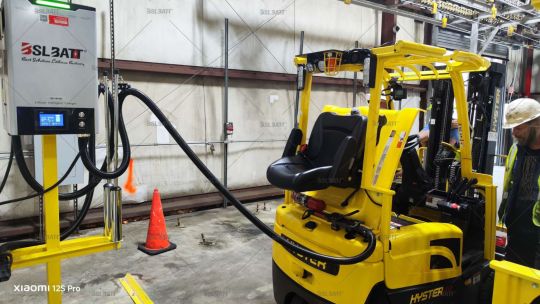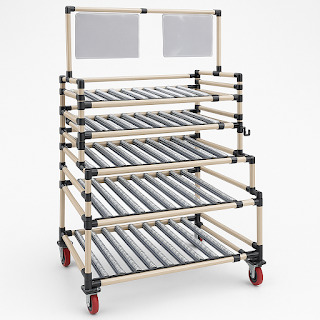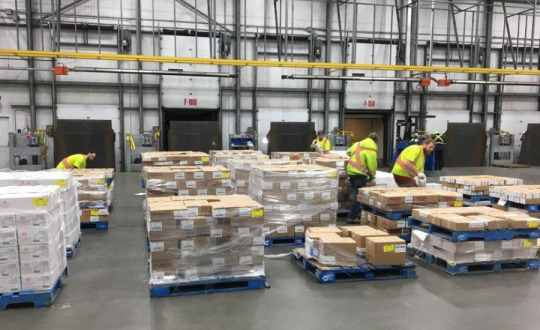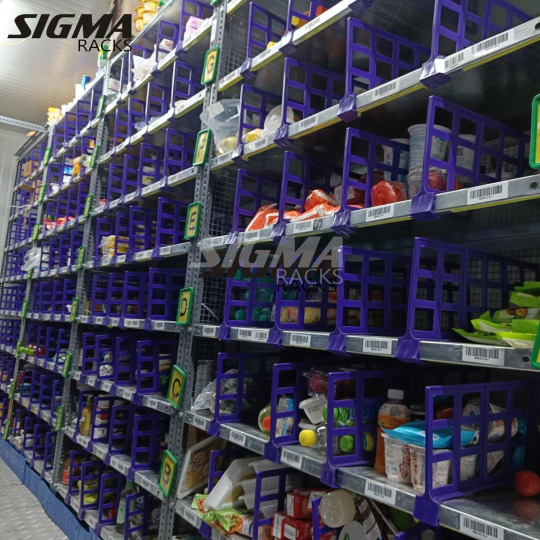#warehouseefficiency
Explore tagged Tumblr posts
Text
youtube
Get in-depth analysis of the India pallet market report 2025! In this comprehensive report, we provide insights into the key trends, market dynamics, and growth opportunities shaping the India pallet industry. Whether you're a industry professional, an investor, or looking to know about the market trends, this report is your go-to resource.
Key Highlights:
Market Overview: Get insights into the historical and forecast data of the India pallet market Market Trends and Drivers: Explore the latest trends and factors influencing market sector, fund size, and funding type. Industry Segment Analysis: Understand Industry Segmentation the market based on type, application, and structural design. Regional Analysis: Get regional Insights and market dynamics impacting different geographical areas. Competitive Landscape: Read about comprehensive overview of key players, their strategies, and market positioning. Report Edition: 2025-2033
Who Should Watch?
Industry Professionals Investors and Stakeholders Researchers and Analysts Food and Beverage Enthusiasts Business Owners and Entrepreneurs
Report Links: https://www.imarcgroup.com/india-pallet-market
Follow us on LinkedIn: https://www.linkedin.com/company/imarc-group/.
Youtube Link: https://youtu.be/zkNxhOEZSoo
Contact Us: IMARC Group 134 N 4th St. Brooklyn, NY 11249, USA Email: [email protected] Tel No: (D) +91 120 433 0800 USA - +1 201971-6302
#IndiaPalletMarket#LogisticsSolutions#SupplyChainIndia#SustainablePallets#EcommerceGrowth#SmartLogistics#WarehouseEfficiency#MakeInIndia#IndustrialGrowth#PalletInnovation#Youtube
0 notes
Text
Objectives of Inventory Management for Efficient Stock Handling

Introduction to Inventory Management Objectives
Inventory management is a key function for every business dealing with products, stock, or supply chains. Whether you're in retail, manufacturing, logistics, or healthcare, handling inventory efficiently helps keep operations smooth and costs under control. The Objectives of Inventory Management focus on maintaining the right balance of stock—avoiding both overstocking and stockouts. In 2025, as technology and customer expectations grow, businesses must align their inventory processes with precise goals to stay competitive.
Why Inventory Management Is Crucial in 2025
In today’s fast-paced market, customer demands are immediate, and delivery expectations are tighter. If businesses don’t have proper inventory control, it can lead to lost sales, high storage costs, and poor customer satisfaction. The Objectives of Inventory Management ensure that companies have the right goods at the right time, without unnecessary waste or delays. With rising inflation, supply chain disruptions, and digital transformation trends, efficient inventory management is more critical than ever.
Key Objectives of Inventory Management
The core Objectives of Inventory Management revolve around maintaining accurate stock levels, ensuring availability, minimizing costs, and improving service quality. These objectives help organizations operate efficiently by reducing losses and increasing profits. Good inventory practices also improve overall planning, purchasing, and warehousing decisions.
Ensuring Product Availability Without Over-Stocking
One of the main objectives is to ensure that the right quantity of products is available when needed. Overstocking can lead to higher holding costs and wastage, especially with perishable or seasonal items. On the other hand, understocking results in lost sales and dissatisfied customers. A well-managed inventory system aims to strike a balance between demand and supply.
Minimizing Inventory Holding Costs Effectively
Another crucial goal is to reduce the cost of holding stock in warehouses. This includes storage, insurance, taxes, depreciation, and obsolescence. The Objectives of Inventory Management aim to minimize these costs by optimizing how much stock is kept and for how long. This not only saves money but also frees up warehouse space for more important items.
Improving Order Accuracy and Fulfillment
Inventory management directly affects order accuracy. Delays in delivery or shipping the wrong products can harm customer relationships. One of the key Objectives of Inventory Management is to ensure that every order is picked, packed, and shipped correctly. Accurate inventory systems help track available stock and reduce the chances of errors.
Optimizing Stock Turnover Rates for Better Efficiency
High turnover rates indicate that goods are being sold and replenished quickly, which is healthy for business. Low turnover can signal excess stock or low demand. Inventory systems should help track turnover and improve efficiency. Meeting this objective ensures that capital isn’t tied up in slow-moving items and helps businesses respond quickly to market changes.
Maintaining Accurate Inventory Records and Data
Having up-to-date and correct inventory data is essential. Inventory inaccuracies can lead to poor decisions in purchasing, sales, and production. Maintaining accurate records is a fundamental Objective of Inventory Management, as it provides real-time insights into what is in stock, what needs restocking, and what should be phased out.
Reducing Wastage, Obsolescence, and Shrinkage
Inventory shrinkage can result from theft, damage, or administrative errors. Obsolete stock refers to items that are no longer sellable. Wastage affects profit margins directly. One of the major Objectives of Inventory Management is to reduce these losses through better planning, tracking, and security measures. Implementing proper systems and employee training can help prevent such issues.
Enhancing Supplier and Vendor Coordination
Good inventory management involves coordination with suppliers to ensure timely deliveries and accurate restocking. Reliable supplier relationships help avoid delays and reduce the risk of running out of stock. Meeting the Objectives of Inventory Management means working closely with vendors to align supply schedules with demand forecasts.
Forecasting Demand with Inventory Control
Demand forecasting plays a major role in inventory success. It helps businesses predict what products are needed, in what quantity, and at what time. This allows for smarter purchasing decisions. The Objectives of Inventory Management include using historical data, market trends, and seasonal patterns to anticipate future demand and avoid last-minute surprises.
Using Technology for Smarter Inventory Decisions
Modern inventory management uses technologies like RFID, barcodes, and real-time tracking systems. These tools improve accuracy, speed, and visibility in inventory operations. Businesses that invest in these systems can meet their inventory goals more efficiently. Automation and cloud-based platforms also help small businesses manage inventory without huge IT investments.
Benefits of Achieving Inventory Management Objectives
When businesses meet their inventory management goals, they enjoy better cash flow, improved customer satisfaction, reduced operational costs, and more reliable planning. It also increases accountability within the organization and allows for more accurate financial reporting. Meeting the Objectives of Inventory Management leads to better control, greater flexibility, and long-term profitability.
AIDC Technologies India: Your Inventory Management Partner
AIDC Technologies India is a trusted provider of advanced inventory and automation solutions. With years of experience in barcode, RFID, RTLS, and warehouse automation, AIDC helps businesses streamline their inventory processes and meet their objectives efficiently. From hardware to software, AIDC offers end-to-end systems designed to improve accuracy, reduce errors, and simplify stock handling.
Whether you are a retailer, manufacturer, or logistics company, AIDC provides customized solutions to help you achieve your specific Objectives of Inventory Management. Their services are scalable, cost-effective, and built to meet industry demands in 2025 and beyond.
Call to Action: Book Now AIDC Technologies
If you're looking to upgrade your inventory system and improve your stock management performance, it's time to act. Book Now AIDC Technologies and experience smarter, faster, and more reliable inventory solutions designed for your business needs.
Conclusion: Smarter Inventory, Smarter Business in 2025
The Objectives of Inventory Management are not just operational tasks—they are the backbone of a successful business. From reducing costs to improving customer satisfaction, efficient inventory management touches every aspect of an organisation. With technology playing a bigger role than ever, businesses must adapt and invest in smarter systems. Partnering with AIDC Technologies India ensures that your inventory goals are met with precision, scalability, and innovation.
#InventoryManagement2025#EfficientStockHandling#SmartInventorySolutions#InventoryOptimization#StockControlStrategies#WarehouseEfficiency#InventoryGoals2025#AIDCInventorySystems#RealTimeInventory
0 notes
Text

BSLBATT Case Study: Hyster-Yale's forklifts at a North Carolina cold storage facility upgraded to BSL's LiFePO4 batteries, boosting performance, efficiency, and uptime in demanding cold environments.
#BSLBATT#LithiumIon#MaterialHandling#ColdStorage#WarehouseEfficiency#BatteryTechnology#Hyster#Aftermarketteam#NorthCarolina#Forklifts
0 notes
Text

📦 Simplify your logistics with Omex CSMS! From inward entry to final delivery, streamline every step with precision ✅ 🔍 Barcode tracking 🔁 Cross-docking 🚚 Efficient inventory movement 📦 Hassle-free storage & delivery
Say goodbye to manual errors and delays—let technology handle the flow! 🙌
🌐 Visit: www.omexcsms.com 📩 [email protected] | 📞 +91 70480 00044
#omexcsms#logisticsmanagement#coldstoragesolutions#inventorytracking#barcodeautomation#crossdocking#supplychaintech#warehouseefficiency#logisticssoftware#smartlogistics
1 note
·
View note
Text
🏭 Top 5 Warehouse Layout Mistakes – and How to Fix Them

Introduction
A poorly planned warehouse layout can cost your business time, money, and productivity. From blocked aisles to inefficient storage zones, small mistakes in warehouse design can create big operational problems. Whether you're setting up a new space or reviewing your current setup, understanding these common mistakes—and how to fix them—can lead to smoother workflows and better space utilization.
Mistake 1: Ignoring Workflow Efficiency
Problem: Many warehouses are designed without considering how materials, people, and machines move throughout the space. This causes unnecessary travel time, delays, and confusion.
Fix: Map out your workflow—from receiving to storage, picking, packing, and shipping. Arrange departments in a logical flow that reduces backtracking. Use visual mapping tools or spaghetti diagrams to find movement bottlenecks.
Mistake 2: Poor Space Utilization
Problem: Too much unused vertical space or crammed floor areas. Either you're not using racking systems well, or aisles are too narrow for forklifts and workers.
Fix: Maximize vertical storage with tall racking systems. Use modular shelving, mezzanine floors, or pipe joint trolleys for dynamic space-saving. Keep aisle widths suitable for your equipment's turning radius.

Mistake 3: One-Size-Fits-All Storage
Problem: Using the same type of shelving or storage for every item—no matter the size, weight, or picking frequency—slows down operations.
Fix: Categorize your inventory (fast-moving, slow-moving, heavy, fragile). Use a mix of storage systems like FIFO racks, bin shelving, and mobile trolleys tailored to product needs.

Mistake 4: No Defined Zones
Problem: When receiving, packing, or dispatch zones overlap, it causes confusion, congestion, and errors.
Fix: Create clearly marked zones for each task: Receiving, Quality Check, Storage, Picking, Packing, and Dispatch. Use color-coded floor tape, signages, or flexible dividers to organize and separate each zone.
Mistake 5: Not Planning for Growth
Problem: Many businesses design their warehouse for the present load, with no plan for future expansion.
Fix: Design your layout to scale with your business. Choose modular equipment and storage solutions that are easy to move or expand, like pipe-joint systems, mobile racks, and stackable bins.
Final Thoughts
Your warehouse layout isn't just about shelves—it's about efficiency, safety, and scalability. By avoiding these 5 common mistakes and implementing smart fixes, you’ll make your warehouse smoother, safer, and more productive.
🔧 Need help designing or upgrading your warehouse? Technovision Engineers Pvt. Ltd. can help you choose the right trolleys, racks, and modular storage solutions to match your needs.
Contact Us 📍 Gat No. 1559-1560, Dehu Alandi Road, Shelarvasti, Chikhali, Pune – 412114, India 📞 +91 77740 20056 / +91 89561 62925 📧 [email protected] 🌐 www.technovisionengrs.com
#WarehouseLayout#LogisticsSolutions#IndustrialStorage#MaterialHandling#SupplyChainManagement#WarehouseEfficiency#ModularStorage
0 notes
Text
How Lumper Services Can Transform Your Warehouse Efficiency
Running a warehouse comes with daily challenges — tight schedules, staff shortages, and backlogs at the dock.
One solution many smart operations managers turn to? Lumper services.
At GroupNB.ca, we provide professional lumper crews that support warehouses across Canada and US with fast, reliable freight handling.
What Are Lumper Services?
Lumper crews are trained professionals who specialize in loading and unloading freight — especially at busy warehouses, retail distribution centers, and trucking terminals.
How Can They Help Your Warehouse?
Reduce Turnaround Times – Faster unloads mean your docks clear out quicker and your carriers get back on the road sooner.
Alleviate In-House Staff Stress – Let your warehouse team focus on inventory, picking, and operations — not unloading 53’ trailers.
Flexible Staffing Without the Headache – Bring in lumpers only when you need them — no need to hire more full-time dock workers during peak times.
Improve Safety & Compliance – Our trained crews know how to handle freight safely and by-the-book, reducing injuries and damage.
Save Money – Reduce overtime pay and downtime fees from delayed shipments. Pay only for the time and crew size you need.
"Using GroupNB's lumper service cut our unload time in half and let our team focus on core tasks. It’s now part of our weekly ops plan." — Warehouse Manager, Fredericton
Whether you manage a cold storage facility, retail DC, or general warehouse, GroupNB’s lumper services can streamline your operations and save your team time.
Learn more or book your crew today: https://groupnb.ca/lumper-services
Have questions? Contact us directly through the website.

#LumperServices#WarehouseEfficiency#DockOperations#GroupNB#NewBrunswickWarehouses#LogisticsSupport#FreightHandling#UnloadHelp#SupplyChainCanada#NBLogistics#OperationsManagement#3PLSupport#WarehouseSolutions
1 note
·
View note
Text
#WarehouseMezzanine#MezzanineSystems#StorageSolutions#IndustrialStorage#WarehouseOptimization#SpaceUtilization#ModularMezzanine#WarehouseEfficiency#RackingSystems#LogisticsSolutions#MaterialHandling#WarehouseExpansion#SmartWarehousing
0 notes
Text
Maximizing Warehouse Efficiency: Strategic Positioning of Material Handling Equipment
Warehouse efficiency isn't just a day-to-day goal in this competitive business environment—it's a key competitive advantage. While most facility managers are focused on replacing equipment or implementing new software programs, the best and most underused tactic may be strategic positioning of material handling equipment. How and where you place your forklifts, pallet jacks, and other gear can make an enormous difference in productivity, safety, and your bottom line.

The Hidden Costs of Suboptimal Equipment Placement
If material handling equipment is installed where access is difficult, the ramifications are far more extensive than mere aggravations. Turn to these ramifications:
- More travel time: Employees traveling long distances to locate equipment translates directly into wasted production time.
- More energy consumption: Equipment idling or unnecessary traversing of the facility wastes fuel and battery life.
- More maintenance cost: Excess movement subjects equipment to greater wear and tear.
- Inefficient use of space: Equipment improperly located can preclude useful storage or working areas.
- Safety risks: Inappropriately located equipment can create risks and increase the potential for accidents.
It's possible for an average-sized warehouse to waste thousands of productive hours annually simply due to inefficient equipment placement. Let's examine how strategic positioning can transform these issues into benefits.
Key Principles for Strategic Equipment Placement
1. Activity-Based Positioning
The rule of thumb for equipment placement is to put resources where they're needed most. This involves understanding your operation's workflow patterns:
- Position forklifts near high-picking volumes or receiving docks with high volumes of heavy loads
- Position pallet jacks in areas of frequent light-to-medium load movement
- Position specialized equipment (reach trucks, order pickers) in their primary places of use
- Designate creating certain "home bases" for gear in the locations that it is utilized most frequently.
Best-functioning warehouses use an area-based equipment allocation system where each working zone will have adequate equipment readily available without redundancy.
2. Traffic Flow Analysis
It is extremely vital to be aware of movement patterns throughout your facility for optimal positioning:
- Map primary travel routes for equipment and individuals
- Identify high-traffic areas and bottlenecks
- Position equipment to minimize cross-traffic and collision risks
- Position equipment paths away from pedestrian paths wherever feasible.
Detailed traffic flow analysis typically reveals the shocking inefficiencies that can often be resolved by smart equipment relocation, in most instances, obviating the need to purchase more equipment.
3. Factors to Do with Charging and Maintenance
For electric-drive equipment, charging station locations need thoughtful consideration:
- Position charging areas close to natural break points in daily workstreams
- Don't place charging points in prime operating area
- Have distributed charging points rather than one location
- Have adequate ventilation and safety clearances around charging locations
Similarly, maintenance areas need to be placed so as to minimize equipment downtime and travel distance for servicing regular needs.
4. Seasonal and Operational Variability
Warehouse operations are not uniform throughout the year. Strategic location of equipment must take into account:
- Seasonal variation in volume
- Special promotion seasons
- Inventory profile fluctuations
- New product launches
The most effective operations create a variety of equipment placement solutions to meet these differences, with defined guidelines for switching between them as business requirements change.
Optimal Placement Implementation Strategies
Begin with Data, prior to rearranging your equipment, collect quantitative data to guide your decisions:
- Monitor equipment use rates by zone
- Measure operators' average travel distances
- Review pick density maps to find high-activity zones
- Review area-specific safety issues from accident reports
This evidence-based approach does not rely on assumption or past operating practices to make decisions.
Pilot Program Approach
Rather than changing an entire facility at one time, attempt to phase it in:
1. Select a starting point for optimizing one zone or process
2. Specify clear success criteria
3. Adjust equipment placement
4. Assess outcome after 30-60 days
5. Iterate from results
6. Roll out to additional zones
This method allows for continuous improvement and minimizes disruption to existing operations.
Equipment Tracking and Accountability
Even a well-designed placement plan fails in the absence of strict adherence. Consider implementing:
- Visual management systems (floor marking, signage)
- Equipment check-in/check-out procedures
- Operator responsibility systems
- Continual auditing of equipment location
- Measurements of performance based on proper equipment return and location.
Some operations have successfully implemented RFID or GPS tracking systems to monitor equipment location in real-time, allowing constant optimization of placement strategies.
Real-World Results
All organizations employing strategic equipment placement report consistent results:
- 15-20% reduction in non-productive travel time
- 10-15% reduction in fuel/power consumption on equipment
- Reduced equipment fleet requirements
- Reduced safety incidents related to equipment movement
- Improved utilization of space throughout the facility
- Improved operator satisfaction and reduced fatigue
One of the Midwest's largest warehouse distribution centers recently reported more than $175,000 per year in cost savings following a comprehensive equipment placement optimization, with ROI within four months.
Beyond Equipment: The Complete Approach
Strategic equipment placement is an effective tool, but it is most valuable when accompanied by complementary methods:
- Ideal slotting and inventory positioning
- Efficient pick path design
- Accurate selection of equipment for specific tasks
- Comprehensively integrated operator training
- Regular readjustment and review of placement plans as operations evolve
Conclusion
Strategic placement of equipment is one of the most cost-effective methods for enhancing the productivity of a warehouse. Unlike many improvement initiatives that entail significant capital outlays, equipment placement optimization is often budget-neutral but delivers dramatic and rapid returns.
By applying data-driven placement methods, tracking performance, and regularly refining your approach, you can convert equipment placement into a powerful weapon of competitive gain. The result is a more efficient, safer, and more profitable operation—all validating that location, in warehouse management, does indeed matter.
#WarehouseEfficiency#MaterialHandling#LogisticsOptimization#WarehouseManagement#SupplyChain#WarehouseLayout
0 notes
Text
How Smart Picking Systems Improve Warehouse Speed and Accuracy?
A warehouse can only run as fast as its picking process. If your team is slowing down, making mistakes, or constantly shifting inventory around, it’s probably not their fault — it’s the setup. A smart picking system, backed by the right warehouse racking, makes a bigger difference than most people realize.
When storage is disorganized or racks aren’t suited for the items being handled, even the most experienced workers waste time. That’s where well-planned warehouse storage solutions come into play. Choosing the right system improves not just space, but also the flow of operations.

Longspan Shelving is a go-to for items that are bulky but still picked by hand. It offers strong support, wide shelves, and easy access — especially useful in facilities where inventory changes often. For smaller or lighter products that need better organization, Slotted Angle Racks are a reliable choice. They’re flexible, easy to adjust, and ideal for medium-duty storage in warehouses or retail backrooms.
When it comes to handling hundreds of small SKUs or parts, Pigeon Hole Racking Systems help keep everything sorted. No more digging or second-guessing — items are right where they’re supposed to be.
Need to keep fast-moving inventory flowing? The use of Live Storage Racks (FIFO) is ideal. These gravity-fed systems allow items to be moved forward in sequence, helping your team pick faster and reduce handling time — especially in high-volume environments.
In addition to storing goods, these systems improve speed, reduce confusion, reduce errors, and ensure that your inventory is visible and accessible.
At Sigma Racks we design and manufacture custom-built Industrial Storage Racks that provide fast, accurate picking and streamlined operations. We provide warehouse storage solutions tailored to fit your needs — and the way in which you work, whether you're upgrading a single section or the entire layout. 🔗 Explore our full range at www.sigmastorage.com 📞 Call us: +91-9670777737 📧 Email: [email protected]
#industrial storage rack manufacturer#slotted angle racks#WarehouseStorage#IndustrialRacks#SlottedAngleRacks#LongspanShelving#SmartPicking#WarehouseEfficiency#PigeonHoleRacks#StorageSolutions#WarehouseRacking#SigmaRacks#PickingSystem#FIFORacks#WarehouseOptimization#RackingSolutions
0 notes
Text

Enhance operational efficiency with a smart Warehouse Management System (WMS). From real-time inventory tracking to seamless team coordination, streamline your entire supply chain using intelligent automation tools. Explore solutions at www.auckam.com for advanced industrial and IoT-driven innovations.
#WarehouseManagement#SupplyChainSolutions#IndustrialAutomation#SmartWarehouse#InventoryControl#LogisticsTech#IoTInLogistics#ManufacturingTech#OperationsManagement#DigitalTransformation#WarehouseEfficiency#TeamCollaboration#RealTimeData#Industry40#SmartLogistics
0 notes
Text
Types of Warehouse Management Systems and their Benefits

Warehouse management has moved far beyond spreadsheets and manual processes. In today’s fast-paced market, businesses need reliable tools to track inventory, reduce errors, and keep operations smooth. That’s where AIDC Technologies India steps in. With years of experience in automation and data capture, AIDC offers tailored solutions built around different Types of Warehouse Management Systems to help businesses of all sizes work smarter.
What Are Warehouse Management Systems? AIDC’s Practical Overview
A warehouse management system (WMS) is a digital solution that helps businesses manage inventory, streamline order fulfillment, and optimize storage space. But it’s not just about keeping count; it’s about making operations faster, more accurate, and easier to monitor. AIDC Technologies India understands that every business is unique, so they provide solutions that adapt to specific industry needs, offering flexibility rather than a one-size-fits-all approach.
Exploring Different Types of Warehouse Management Systems with AIDC India
Understanding the Types of Warehouse Management Systems is the first step to choosing the right fit. At AIDC, these typically include:
Standalone WMS: Focused solely on managing warehouse tasks like picking, packing, and shipping.
Integrated WMS: Works alongside ERP or supply chain software for complete business management.
Cloud-Based WMS: Hosted online, allowing real-time access and updates from anywhere.
On-Premise WMS: Installed locally for full control and data security.
AIDC Technologies India helps businesses evaluate these options to find the system that aligns with their size, complexity, and future growth plans.
Key Features That Make AIDC’s WMS Solutions Stand Out in 2025
AIDC’s approach isn’t just about technology—it’s about creating systems people actually find easy to use. Their solutions often include barcode and RFID integration for fast scanning, user-friendly dashboards for real-time insights, and automated alerts to prevent stockouts. As part of their commitment to innovation, AIDC also supports mobile device integration so staff can update records and check inventory directly from the warehouse floor.
Benefits of Choosing the Right WMS for Your Business
Choosing among the Types of Warehouse Management Systems isn’t just a technical decision—it directly affects daily operations. With the right system in place, businesses can:
Reduce manual errors and save time
Improve order accuracy, leading to higher customer satisfaction
Optimize space by tracking stock levels in real time
Gain better visibility into fast-moving and slow-moving items
Reduce costs associated with overstocking or lost inventory
AIDC Technologies India ensures clients experience these benefits by providing systems that match real business needs, not just software features.
Enhancing Efficiency and Accuracy: AIDC Technologies’ Smart Approach
One of the biggest advantages of a good WMS is improved efficiency. AIDC Technologies India designs systems that automate routine tasks—like generating pick lists or flagging low stock—which frees staff to focus on more important work. Barcode and RFID integration make data entry nearly instant, lowering the chance of mistakes. And with clear reporting tools, managers always know what’s happening in the warehouse without needing to walk the floor.
Industry Applications: Where AIDC India’s WMS Makes a Difference
Different industries have different needs, which is why understanding the Types of Warehouse Management Systems matters. For instance:
Retail: Fast order fulfillment and returns management
Manufacturing: Tracking raw materials and finished goods
E-commerce: Managing high-volume, small-package shipments
Healthcare: Ensuring critical supplies are available and tracked securely
AIDC Technologies India customizes WMS solutions to these specific requirements, so businesses get systems built to solve their actual challenges.
Future Trends: AIDC India Shaping Next-Generation WMS Solutions
Looking ahead, warehouse management is set to become even smarter. AIDC Technologies India is exploring features like AI-driven demand forecasting, real-time tracking with IoT sensors, and fully cloud-based systems that integrate easily with other business tools. These innovations promise to make choosing between different Types of Warehouse Management Systems not just about what works now, but also what keeps businesses competitive tomorrow.
Why Partner with AIDC Technologies India for Warehouse Management Systems
What sets AIDC Technologies India apart is their focus on customization, support, and practical design. They don’t just install software; they work closely with clients to map current processes, identify gaps, and build systems that truly make work easier. Their years of experience in barcoding, RFID, and data capture technology mean they understand both the technical side and the real-world needs of warehouse teams.
Conclusion: Streamline Your Operations with AIDC’s WMS Solutions
Choosing the right system among the Types of Warehouse Management Systems can transform how your warehouse runs—saving time, reducing errors, and improving customer service. AIDC Technologies India brings industry expertise, practical design, and a customer-first approach to every project.
If your business is ready to explore smarter ways to manage inventory, Book now with AIDC Technologies India and see how the right warehouse management solution can help you succeed in 2025 and beyond.
0 notes
Text

🚀 Another Successful Conversion to Lithium-Ion!
We’re thrilled to share that another customer has upgraded their Linde Material Handling forklift from lead-acid to BSL lithium-ion batteries—unlocking greater efficiency in their warehouse operations!
🔋 Why they made the switch: ✅ Drop-in replacement for seamless integration ✅ Opportunity charging for uninterrupted productivity ✅ Longer cycle life & fewer replacements = lower TCO ✅ Space-saving design maximizes warehouse floor space
Whether you run forklifts or automation equipment, our lithium batteries deliver reliable power, long-term value, and unmatched support.
At BSL Battery - Industrial, we don’t just provide power—we partner with you for success. 💡
Learn how we can optimize your operations today!
Contact The Top Lithium-ion Battery Provider | BSLBATT
0 notes
Text

Strength Meets Durability
Designed for demanding industries, our EP Conveyor Belts offer superior strength, flexibility, and longevity.
Upgrade to a conveyor belt that keeps your operations running smoothly!
📞 Call: +919025194360
🌐 Visit: www.lakhotiaindia.in
#EPConveyorBelts#HeavyDutyPerformance#IndustrialStrength#MaterialHandling#DurableConveyors#LakhotiaIndia#ReliableSolutions#ToughWorkloads#WarehouseEfficiency
0 notes
Text

Ready to revolutionize your warehouse operations? With our mobile stack solution, you can enjoy paperless operations, path optimization, seamless integration, and real-time analytics—designed to boost efficiency and productivity. Achieve a 25% increase in warehouse productivity, 50% faster picking, and 100% inventory accuracy and visibility across your entire network.
Visit us today for a customized demo and see how our mobile stack solution can transform your business!
For Business need, reach us out at +91-9266426868 or email us at [email protected].
#WarehouseAutomation#SupplyChainSolutions#MobileStack#Daakit#InventoryManagement#WarehouseEfficiency#ecommercelogistics#next day delivery#shippingsolutions#supplychainmanagement#logistics#logisticsaggregator#same day delivery#same day & next day delivery
0 notes
Text
Cubuilt Engineers Pvt Ltd specializes in manufacturing various types of Material Handling Trolleys, including Manually Transfer Trolleys, Electrical/Battery Operated Transfer Trolleys, and Motorized Transfer Trolleys. These trolleys are designed to efficiently transport heavy items across different sections of a facility, operating on ground-level rails and offering self-driven or motorized options. Cubuilt+2Cubuilt+2Cubuilt+2
Key Features:
Variety of Options: Choose from manually operated, battery-powered, or motorized trolleys to suit specific operational needs.
Efficient Load Handling: Designed to move heavy loads smoothly, enhancing productivity and reducing manual labor.
Durable Construction: Built to withstand industrial environments, ensuring longevity and reliable performance.
Applications:
Ideal for transporting materials between different departments or workstations within manufacturing units.
Suitable for environments where heavy items need to be moved safely and efficiently over short distances.
Integrating Cubuilt's Material Handling Trolleys into your operations can significantly improve efficiency, safety, and workflow within your facility. For more detailed information on specific models and customization options.
please visit :- https://cubuilt.com/products/material-handling-trolley/
#MaterialHandlingTrolley#Cubuilt#IndustrialEquipment#LoadTransport#WarehouseSolutions#ManufacturingExcellence#HeavyLoadHandling#LogisticsSupport#OperationalEfficiency#CustomizableTrolleys#BatteryOperatedTrolley#MotorizedTrolley#ManualTrolley#FactoryAutomation#MaterialHandlingSolutions#WarehouseEfficiency#IndustrialLogistics#HeavyDutyTrolley#AssemblyLineSupport#ProductivityEnhancement#SafeMaterialHandling#WorkshopEquipment#SupplyChainOptimization#MadeInIndia#EngineeringInnovation
0 notes
Text



At LG Lift, we understand the importance of efficiency in your daily operations. Our customizable scissor lift tables are designed to make loading, unloading, and lifting easier, safer, and more efficient for your business.
Imagine a scenario where you're easily lifting heavy goods or vehicles with minimal effort—thanks to our reliable lift tables, your team can focus on what really matters: productivity. Whether it’s for warehouse tasks, vehicle maintenance, or managing heavy inventory, our lift tables are built to handle the job smoothly.
🔧 Why Our Lift Tables?
Tailored to your needs: Custom sizes and features to fit your workflow.
Simple to operate: Effortlessly raise and lower heavy items with a push of a button.
Built for durability: Designed for long-lasting performance, even in the toughest environments.
Don’t let heavy lifting slow you down. Upgrade your process with a solution that’s designed to help you work smarter!
📩 Contact us today to learn more and find the right lift for your needs.
Email: [email protected]
WhatsApp: +86-18615633168
#ScissorLifts#WarehouseEfficiency#CustomLifts#LGift#HeavyLiftingSolutions#Logistics#ProductivityBoost
0 notes